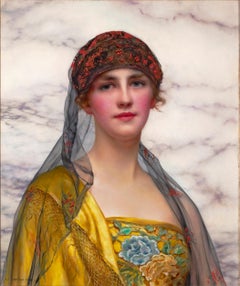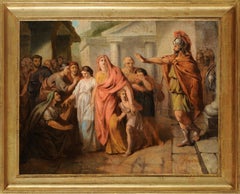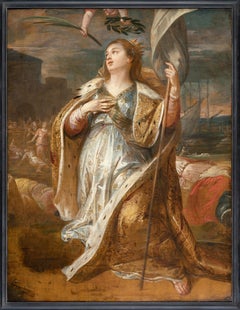William Clarke Wontner Figurative Paintings
to
1
Overall Width
to
Overall Height
to
1
1
1
1
1
1
1
1
1
1
1
1
1
466
321
258
228
1
1
Artist: William Clarke Wontner
Portrait of a Beauty by William Clarke Wontner
By William Clarke Wontner
Located in New Orleans, LA
William Clarke Wontner
1857-1930 British
Portrait of a Beauty
Signed and dated "W. Wontner 1918" (lower left)
Oil on canvas
Classical beauty a...
Category
20th Century William Clarke Wontner Figurative Paintings
Materials
Canvas, Oil
Related Items
Alexander the Great in the Darius house
Located in BELEYMAS, FR
French School, Late 18th Century
Alexander the Great in the House of Darius
Oil on canvas
H. 42 cm; W. 53.5 cm without frame
Apocryphal signature lower right "Verhag..."
This painti...
Category
1780s French School William Clarke Wontner Figurative Paintings
Materials
Canvas, Oil
Boeckhorst, Rubens, Saint Ursula, Decorative Old Master, Woman, Baroque, Flemish
By Jan Boeckhorst
Located in Greven, DE
Johann Boeckhorst (Münster 1604 - Antwerp 1668)
Saint Ursula
Oil on canvas, 112 x 86 cm
Provenance:
New York, Christe's, 20.3.1981, lot 88 (as Van Diepenbeeck's circle)
The presen...
Category
17th Century Baroque William Clarke Wontner Figurative Paintings
Materials
Canvas, Oil
$52,874 Sale Price
25% Off
H 44.1 in W 33.86 in
Holy family under an oak tree on a gold background
Located in BELEYMAS, FR
French school circa 1870
Holy Family under an oak, after Raphaël, on gold background
Oil on canvas
H. 92 cm; W. 60 cm
This aesthetic curiosity takes up the very famous composition b...
Category
19th Century French School William Clarke Wontner Figurative Paintings
Materials
Canvas, Oil
Portrait of a man in armor
Located in BELEYMAS, FR
Attributed to Jacques DUMONT aka DUMONT LE ROMAIN
(Paris 1701 - 1781)
Presumed portrait of Louis-Joseph de Formanoir (?-1732)
Oil on canvas
H. 91.5 cm; L. 73 cm
Signed on the helmet:...
Category
1750s French School William Clarke Wontner Figurative Paintings
Materials
Canvas, Oil
Portrait of a couple
Located in BELEYMAS, FR
Jean-Baptiste SANTERRE
(Magny en Véxins 1651 - Paris 1717)
Portrait of a couple
Oil on original oval canvas
H. 115 cm; L. 90 cm (140 x 115 cm with frame)
Around 1695
Jean-Baptiste S...
Category
1690s French School William Clarke Wontner Figurative Paintings
Materials
Canvas, Oil
Portrait of a young man with a turban
Located in BELEYMAS, FR
Circle of Adam de Coster
(Mechelen 1586 – Antwerp 1643)
Portrait of a Young Man with a Turban, Dressed in Oriental Style
Oil on canvas
H. 43 cm ; W. 33 cm
Unsigned
This portrait of ...
Category
1620s Flemish School William Clarke Wontner Figurative Paintings
Materials
Oil, Canvas
The pianist
Located in BELEYMAS, FR
Jean CLUSEAU-LANAUVE
(Périgueux 1914 - Paris 1997)
The Pianist
Oil on canvas
H. 46 cm; W. 38 cm
Signed lower right. Countersigned, titled, and dated on the back - 1962
Provenance: E...
Category
1960s French School William Clarke Wontner Figurative Paintings
Materials
Oil, Canvas
A Chinese Company playing Droughts
Located in Amsterdam, NL
ERWIN BINDEWALD (1897-1950)
Two men playing draughts, a girl with the red book standing behind them
Signed and dated E. Bindewald d.j., 27
Oil on canvas, 140.5 x 90.5 cm
In black and gilt gesso frame.
Note:
Bindewald was born in Charlottenburg. He moved to Berlin in 1914 where he studied till 1924 at the Berliner Kunst Akademie. Bindewald travelled in Europe, but mainly stayed in Germany and certainly never was in China. This painting was made in Europe, presumably in the China Town of Berlin. Bindewald received several commisions in Germany from factory owners who wanted their factories painted inside, usually with workers, as well as outside. In the present painting the sitter on the right seems to be a man with a Manchurian background, wearing the brown coat reserved for the highest aristocracy in China.
In China the black sleeve-ends completely cover the hands, indicating that the high aristocracy does not have to do any manuel labour. This man clearly is not a factory worker but he possibly is the (co)- owner of the factory in the background and as such might need his hands to do at least some writing. The man on the left in the modern Western suit...
Category
1920s Art Deco William Clarke Wontner Figurative Paintings
Materials
Canvas, Oil
Cavalry review of the 2nd Lancers regiment
Located in BELEYMAS, FR
Georges HYON
(Paris 1840 – Saint Germain en Laye 1913)
Cavalry review of the 2nd Lancers regiment
Oil on canvas
H. 115 cm; W. 146.5 cm
Signed lower left
A student of Portalis, Georg...
Category
1870s French School William Clarke Wontner Figurative Paintings
Materials
Canvas, Oil
Italian men portrait
By Giovanni Maria delle Piane dit Mulinaretto (Genoa 1670 - Monticelli d´Ongina 1745)
Located in BELEYMAS, FR
Giovanni Maria DELLE PIANE, known as IL MULINARETTO
(Genoa, 1660 – Monticelli d'Ongina, 1745)
Portrait of a man
Oil on oval canvas
H. 108 cm; L. 83 cm
Provenance: Nino Ferrari Colle...
Category
1740s Italian School William Clarke Wontner Figurative Paintings
Materials
Canvas, Oil
Four large French family portraits
Located in BELEYMAS, FR
Suite of four large family portraits, kept together to this day. Created around 1840 by the painter Théophile Morel, who presented portraits at the Salon des Artistes Français from t...
Category
1840s French School William Clarke Wontner Figurative Paintings
Materials
Canvas, Oil
Presumed artist self-portrait
Located in BELEYMAS, FR
Louis-Gabriel BLANCHET
(Versailles, 1701 – Rome, 1772)
Presumed self-portrait of the artist
Oil on canvas
H. 73 cm; W. 60 cm
Circa 1730
Originally presented in a Restoration period frame with a "Mignard" cartouche, this beautiful painting initially appeared to us as a work from northern Italy. However, it exuded a rather French form of refinement, suggesting that its artist may have assimilated a dual influence from both sides of the Alps.
We thank our colleague and friend Philippe Mendès for spontaneously and judiciously "bringing out" the name of Louis-Gabriel Blanchet, a Romanized French portraitist, whose spirit and stylistic characteristics we clearly recognize here.
Blanchet's "French" years, before his final departure for Rome in 1728, following his winning of the second Grand Prix for painting after Subleyras in 1727, are extremely poorly documented. His father, Gabriel, was valet to Blouin, himself Louis XIV's first valet at the time. According to Thierry Lefrançois, Blanchet was one of the few students of Nicolas Bertin (1667-1736), whose studio he is said to have joined in the early 1720s. At a baptism on March 24, 1724, where he was godfather, he is mentioned as a painter in the picture store of the Duke of Antin, the director of buildings between 1708 and 1736. At this time, he was probably already married to Jeanne Quément, with whom he had a daughter also named Jeanne, who would marry Nicolas Aviet, the son of a valet in the queen's wardrobe, in Versailles in 1738.
When Blanchet arrived in Rome in October 1728, he was accompanied by Subleyras, Trémolières, and Slodtz. He enjoyed the goodwill of Vleughels, the director of the Académie de France, which had been based at the Palazzo Mancini since 1725, even though the latter was not always kind to our resident. From 1732, he was under the protection of the Duke of Saint-Aignan when he took up his post as ambassador to Rome. Along with Slodtz and Subleyras, they formed a trio of friends, joined by Joseph Vernet shortly after his arrival in Rome in 1734. Slodtz and Blanchet, on the occasion of Subleyras's marriage in 1739, were there to attest that their friend was not bound by any marital commitment, and Blanchet was a witness at Vernet's wedding in 1745.
It is most likely from these early years in Rome that our portrait of the artist dates, the expression and turn of his face irresistibly reminiscent of a self-portrait. The still relatively youthful features may correspond to Blanchet's thirty-something years, and the fluffy wig was still fashionable at this time.
The painting fits well with the depiction of a young painter wanting to display both the beginnings of success and a certain simplicity or restraint. A slight smile expresses a form of assurance in this man with a gentle, sincere gaze and a face radiating a keen sense of wit. We find here the air of intimacy present in almost all of Blanchet's portraits, even those from the 1750s and 1760s, as well as an almost complicity with the viewer. The spirit of the painting is quite close to that of the presumed portrait of Bouchardon (painted around 1730) and the portrait of Pannini, painted in 1736, but it possesses a more natural quality, notably thanks to the absence of decorum. Our work exhibits the characteristics of Blanchet's paintings: elegance, luminosity (especially in the whites), vibrant and refined colors (here, the harmony of the garnet of the garment and the slate blue of the background, whose uniformity is tempered by a very sketched landscape and a grove of greenery), light complexions, rather rosy cheekbones, often full lips, and rather tight framing.
According to the Academy's rules, Blanchet's stay should have ended in the spring of 1732, but, for reasons unknown, he remained in the Eternal City until his death, as did his friend Subleyras, with whom he shared accommodation until the late 1730s. The latter regularly called upon him to collaborate on his paintings, such as The Meal at Simon's. Through Saint-Aignan's intervention, Blanchet was employed in the late 1730s by the Stuart princely family, then exiled in Italy. He notably produced copies (now lost) after Liotard of the portraits of Charles Edward and Henry Benedict, the sons of James III Stuart. The latter also commissioned three other portraits (now in the National Portrait Gallery in London), whose more formal character contrasts with the intimate spirit of Blanchet's portraits. Blanchet frequented English painters, such as the landscape painter Richard Wilson, and studied with the Scottish portraitist Katherine Read...
Category
1730s French School William Clarke Wontner Figurative Paintings
Materials
Oil, Canvas
William Clarke Wontner figurative paintings for sale on 1stDibs.
Find a wide variety of authentic William Clarke Wontner figurative paintings available for sale on 1stDibs. You can also browse by medium to find art by William Clarke Wontner in canvas, fabric, oil paint and more. Not every interior allows for large William Clarke Wontner figurative paintings, so small editions measuring 32 inches across are available. Customers who are interested in this artist might also find the work of Francis Plummer, David Shrigley, and George Edwards. William Clarke Wontner figurative paintings prices can differ depending upon medium, time period and other attributes. On 1stDibs, the price for these items starts at $198,500 and tops out at $198,500, while the average work can sell for $198,500.


